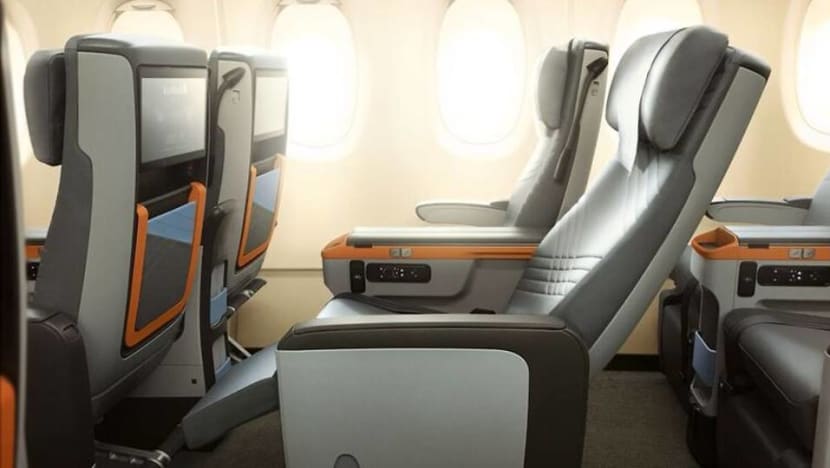Commentary: US$400 for a 4-hour nap on an economy flight? Where do I sign up
If there is one thing frequent flyers dread, it is going sleepless on a long flight. The challenge is for airlines to innovate unique solutions and figure out the sweet spot that passengers are willing to pay for some shut-eye, says travel journalist Karen Tee.

Air New Zealand is set to launch bunk bed style sleeping pods, termed Skynest, for economy class passengers on selected long-haul flights in September 2024. (Photo: Air New Zealand)
SINGAPORE: Like many frequent flyers, I find that the worst part about taking a long-haul or red-eye flight is being unable to sleep. After all, being left bleary-eyed from a sleepless flight and that feeling of disorientation and sleep deprivation in new surroundings is not a fun way to kick off a trip - be it for work or leisure.
Unfortunately for the legions of us who are not blessed with the ability to fall asleep while sitting upright, being packed into an economy class or budget flight seat is not quite conducive to drifting off to dreamland.
No matter the airline, coach seats seem to have ever-shrinking legroom and backrests with miniscule reclining angles that make it hard for one to find a restful position to catch some much-needed sleep.
Plus, with most of the plane’s passengers seated in "cattle class", the cabin tends to be rather busy throughout a flight. Besides constant interruptions for meal or drink service, one also has to deal with fellow passengers clambering over seatmates and shuffling up and down the aisles to go to the toilet or to simply stretch their legs.
Not to mention, it takes just one wailing child to disrupt the entire cabin (noise cancelling headphones can only block out that much ambient sound).
The recent news that Air New Zealand is set to launch bunk bed style sleeping pods for economy class passengers on selected long-haul flights in September next year garnered much chatter online.
These Skynest sleeping areas, which resemble capsule hotel pods, will cost between NZ$400 and NZ$600 (US$244 and US$365) for a four-hour block, in addition to the regular cost of the air ticket.
Some people have criticised the airline for “doing everything they can to make more money”, others have said it works out cheaper than paying for a business class long-haul flight.
AFFORDABLE LUXURY IN POST-PANDEMIC ERA
Yet, can you really blame the airlines for trying to rebuild their coffers after losing a combined US$200 billion between 2020 and 2022?
During the pandemic, air travel skidded to a near halt as countries closed their borders and movement restrictions kept people at home. The aviation industry took a major hit and some airlines, including Thai Airways and Virgin Australia, entered into bankruptcy.
Now that travel is back, international air fares have soared, in some cases to more than 50 per cent what they were pre-pandemic. This can be attributed to consumers, starved of travel during the COVID-19 days, who are keeping demand high now that borders have reopened.
According to the International Air Transport Association's latest data, international passenger traffic rose 48 per cent year-on-year in April, with carriers in the Asia-Pacific region continuing to lead the recovery. Globally, traffic is now at 90.5 per cent of pre-COVID levels and shows no sign of letting up.
I’ve been fortunate enough to fly in business class a few times (thank you, airline miles) and enjoy the luxury of a fully flat-bed seat. Sadly, such upgrades are relatively scarce and generally cost way too many miles, which means it is impossible to score a coveted business class seat each time I take a red-eye flight.
The reality too is that business class fares are astronomical for most individuals - myself included.
So Air New Zealand’s sleeping pods are quite an ingenious "affordable luxury" concept in this post-pandemic era where the rising cost of travel has been widely documented, making every trip all the more precious.
For some passengers, the few extra hundred dollars is priceless if they get to have quality sleep and start of their long-awaited trip feeling refreshed.
After all, while an increasing number of airlines, including Singapore Airlines, offer premium economy or economy plus seats with wider seats, greater recline angles and more legroom, such seats do not have a flat-bed reclining capability. They are certainly comfortable but may not necessarily do the trick for finicky sleepers.
Such premium economy seats generally cost about 20 per cent to 50 per cent more than economy class, which means one can expect to pay anything between several hundred to over a thousand dollars for this upgrade.

This makes the roughly NZ$100-an-hour nap on Air New Zealand’s Skynest a sweet spot for those who might be debating whether it’s worth forking out money for a premium economy or business class seat.
SOME SLEEP IS BETTER THAN NONE
My only grouse would be that passengers are limited to only one four-hour block per flight.
However, according to research, each sleep cycle averages 90 minutes, which means four hours is generous enough for a passenger to wind down, get that 90-minute cycle in and gently awaken before they have to return to their economy seat.
As a plebeian traveller on a budget, some quality sleep is certainly better than none, so I would gladly pay for this privilege.
The larger question is that as travel demand continues, will more airlines start to innovate more flat-bed options for economy class passengers.
Some airlines, including Air New Zealand and All Nippon Airways, have pioneered “sleeper rows” where passengers can pay an additional fare on selected flights to book a row of coach seats. These seats typically come with leg rests that can flip up to create a broader lie-flat space.
While solo travellers might still find it pricey to buy out an entire row of seats, couples or families with young children will surely enjoy this option of sharing three economy class seats among two people.
Still, to the best of my knowledge, there are currently no flights originating out of Singapore that offer such sleeper options in economy yet. So those who wish to enjoy this will have to catch connecting flights from neighbouring cities.
In the meantime, while we wait with bated breath - your move, Singapore Airlines - I think I may have finally found a sure-fire way to combat this sleeplessness on a red-eye.
On a recent eight-hour overnight flight from Tashkent, Uzbekistan to Kuala Lumpur, I slumbered blissfully through most of the flight even in an "uncomfortable" economy class seat.
My whirlwind one-week trip through the Central Asian country was so hectic that by the time I boarded the plane, nothing, not even a sardine-packed flight, could keep me from drifting off to dreamland.
As it turns out, short of paying big bucks for business or first class, exhaustion is possibly the best cure for in-flight insomnia.
Karen Tee is a freelance lifestyle and travel journalist based in Singapore.


















